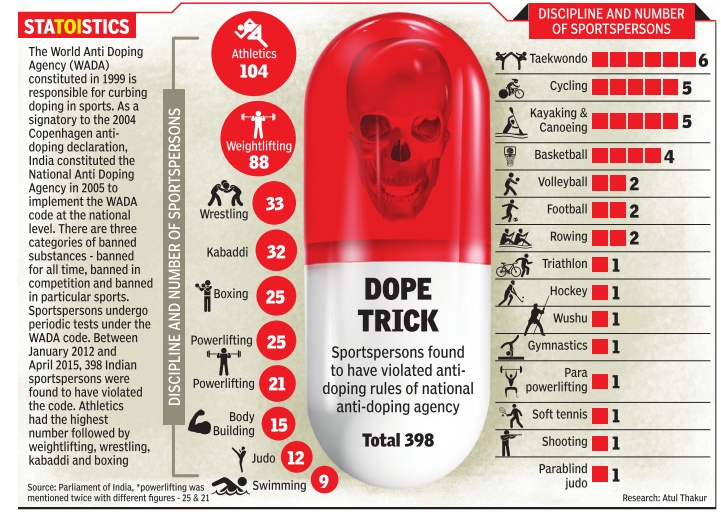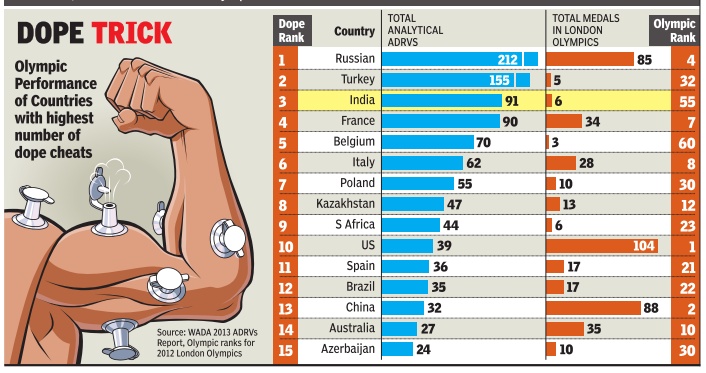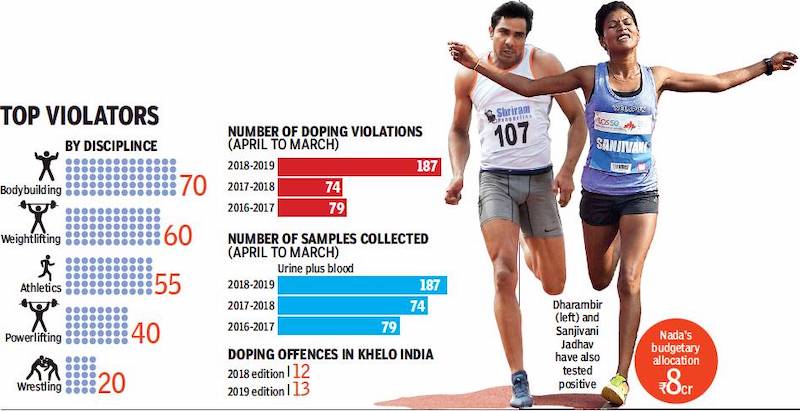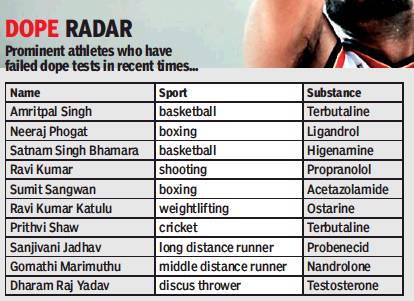Doping in sports: India


This is a collection of articles archived for the excellence of their content. |
Contents |
Doping in sports: In brief
The Hindu, July 27, 2016
Depalakshmi K.
What are performance-enhancing drugs?
Performance-enhancing drugs, or PED, are substances used to improve performance in any form of activity. They usually work by causing the body to build more muscles or by limiting muscle fatigue. They are mostly Anabolic Steroids, synthetic versions of the male hormone Testosterone. There are also non-steroidal PEDs. A common example is Ibuprofen, a painkiller that can be bought without a prescription at medical stores. It limits the inflammation associated with physical exercise.
Who decides if a drug is PED or not?
The World Anti-Doping Agency (WADA) monitors doping in all kinds of competitive sports. Created in 1991, WADA is an independent international agency funded by sports organisations and associated countries. It monitors doping in sport based on the World Anti-Doping Code.
At the national-level, there is the National Anti-Doping Agency (NADA), an independent body under Union Ministry of Sports.
What is WADA Code?
The WADA Code or simply the Code is a document aiming to harmonise anti-doping regulations in all sports and across countries. It has been adopted by over 600 sports organisations. The Code works on five aspects:
Prohibited List: The WADA periodically updates its list of Prohibited Substances and Methods. This includes steroids, anabolic agents, stimulants, and gene doping. Some components such as narcotics are permanently banned. Some, like alcohol, are banned only in-competition. Click here to read/download the full list.
Testing and investigations: The Code has prescribed International Standard for Testing and Investigations. It has laid out elaborate procedures to notify athletes, collect samples, conduct tests, and investigate a possible failure to comply these rules. The Code has set 10 anti-doping rule violations (ADRV). Violation of one or more of these rules entertains investigation.
1. Presence of a prohibited substance in an athlete’s sample
2. Use or attempted use of a prohibited substance or method
3. Refusing to submit to sample collection after being notified
4. Failure to file athlete whereabouts information & missed tests
5. Tampering with any part of the doping control process
6. Possession of a prohibited substance or method
7. Trafficking a prohibited substance or method
8. Administering or attempting to administer a prohibited substance or method to an athlete
9. Complicity in an ADRV
10. Prohibited association with sanctioned Athlete Support Personnel
Laboratories: The WADA doesn't directly conduct tests. It gives accreditation to laboratories which adheres to the mandatory International Standard for Laboratories. The Code also elaborately lays down rules on how to collect samples and conduct tests, besides keeping the investigation confidential. The laboratory cannot test commercial products and certify them, without WADA's approval.
Therapeutic Use Exemptions (TUEs): The Code also has provision to provide or seek exemption for certain drugs, if they are used for treating acute or chronic medical condition and if no other alternative option is available for treatment. The use of such drugs should not produce any additional enhancement of performance.
Protection of Privacy and Personal Information: This part of Code deals with the confidentiality clause. The personal information processed in connection with anti-doping activities is protected in adherence to international privacy laws.
When will an athlete be tested?
Any sportsperson competing in national or international events can be asked to give his/her blood and/or urine samples at any point of time by anti-doping agency or sports events committee during the event. Testing can be conducted in-competition and out-of-competition. Usually athletes who bag the finishing positions are tested. In addition, agency can randomly test any accredited athlete, even when not participating in an event.
What is the punishment, if found guilty?
Sanctions for violating anti-doping regulations may range from a reprimand to a life-time ban, according to WADA. The period of ban may vary depending on the type of anti-doping violation, the circumstances of an individual case, the substance, and the possible repetition of an anti-doping rule violation. The decision to strip the medal, however, lies with the sports organisation.
Can the athlete appeal?
The athlete is entitled for a fair hearing and appeal on any decision regarding a positive test or sanction imposed for an anti-doping rule violation. The athlete can also request a re-test — B sample analysis.
What about nutrients or dietary supplements?
There is no blanket ban on using dietary supplements or nutrients. But there has been several instances of dietary supplements containing prohibited substances but are not declared by the manufacturer. WADA does not accept this as an adequate defence and hence the onus is on the athletes to choose their supplements.
The extent of the problem
As in 2019; 2016-19
Sabi Hussain, July 23, 2019: The Times of India

From: Sabi Hussain, July 23, 2019: The Times of India
For years, India maintained its dubious record of being among top 10 nations in the world in doping violations. For three years straight between 2013-15, India was ranked third, after Russia (176 violations) and Italy (129).
In 2015 alone, the country had 117 sportspersons who tested positive by the list published by the World Anti-Doping Agency (Wada). It was only in 2016 that India was declared joint-sixth among the dope violator countries with 69 antidoping rule violations (ADRV).
However, the number of dope cheats have risen significantly in the previous financial year as per the National Anti-Doping Agency (NADA) records. Out of the 4348 samples (urine and blood) collected, 187 have returned dope positive. For the financial year 2017 to 2018, the number of dope cheats stood at 74 out of the 3822 samples collected.
Recently, several athletes, including an international medallist, ran away from the national camp at the SAI centre, Bengaluru when the Nada’s Dope Control Officers (DCOs) visited the campus for sample collection. Similarly, a toplevel wrestler escaped the clutches of DCOs at the SAI centre, Sonepat when he saw the Nada officers. Same was the case with a few track and field athletes at the NIS, Patiala when they left the premises without informing anyone. All these athletes have been provisionally suspended by the Nada, according to informed sources. In last few months, Nada’s figures revealed that it has provisionally suspended sportsperson who have represented the country and even won medals at the CWG, Asiad, Commonwealth and Asian championships.
Juniors aren’t far behind and the most worrying part is the spurt in the number of cases at the school and college level. The government’s flagship programme, Khelo India, is at the forefront of this menace. The inaugural edition of the 2018 Khelo India School Games (KISG) saw a total of 12 dope failures. This year’s edition in Pune, the Khelo India Youth Games (KIYG) where U-21 age-category athletes competed, has already seen those numbers surpassed – a total of 13 dope failure. Among them were Commonwealth youth championship silver winner weightlifter Lalitha Gara and top volleyball player, Amit Kumar. Some of them returned positive for performanceenhancing drugs like testosterone, tamoxifen and erythropoietin (EPO).
More than the kids, it’s the failure of the Sports Authority of India (SAI), sports federations and the coaches imparting training to these young talents that they couldn’t educate them enough about the consequences of doping. However, it’s the coaches who deserve the maximum punishment for resorting to short cuts and pushing their wards to cheat. The government is in the process of introducing the anti-doping legislation to criminalise doping. As per this act, any attempt by coaches to indulge in supply of prohibited substances to an athlete or having linked to an ‘organised crime syndicate’ involved in doping will attract a jail term of up to four years or result in imposition of a fine of Rs 10 lakh.
In a nation starving for sporting success, it’s the hunger for crores offered in cash awards by state governments that is also forcing the athletes to cheat. Haryana government offers Rs six, four and 2.5 crore for medal winners at the Olympics. Same is the case with the Telengana government and with many other states.
It’s always encouraging to award the performance of an athlete, who has risen through the ranks under trying circumstances to bring medal glory to the nation. But when we are talking about crores, the chances of doping equally remain high.
Hall of shame
2018: Sanjita caught in doping net
Doping menace has come back to haunt Indian weightlifting. In a shocking development, leading woman weightlifter and two-time Commonwealth Games champion, Khumukcham Sanjita Chanu, has failed a dope test. Her sample has tested positive for anabolic steroid testosterone, resulting in her immediate provisional suspension by the International Weightlifting Federation (IWF) on Thursday.
Sanjita, who holds the distinction of becoming only the second woman weightlifter after Kunjarani Devi to win gold in two different editions of the CWG (Glasgow 2014 and Gold Coast 2018), now runs the risk of losing her Gold Coast CWG gold in the women’s 53kg category.
“IWF reports that the sample of Sanjita Chanu Khumukcham has returned an adverse analytical finding for testosterone (S1.1 anabolic agents). As a consequence, the athlete is provisionally suspended in view of a potential anti-doping rule violation,” the IWF said.
Shocked at the news, Sanjita is now hopinbg to come out clean from the doping slur.
“I have only taken supplements provided by the Federation and my samples (both urine and blood) have been tested many times but it was always negative,” Sanjita Chanu told TOI on Thursday.
“Before I left for the Worlds I gave my sample and the NADA/WADA team took my sample again in Patiala after we returned from USA. So I’m puzzled how this sample, which was given in between these two tests turned positive?” she wondered. “If the B sample is also positive, then I’m sure something has happened. Either, they tested the wrong sample or someone spiked my sample. We all took the same supplements and how come only my sample returned a positive test. It can’t happen that away,” Chanu added.
Initiatives to prevent doping in sports
App (lication): Pharma Jan Samadhan
NPPA, NADA app to help athletes identify prohibited medicines, August 29, 2017: India Today
Drug pricing regulator NPPA joined hands with National Anti-Doping Agency (NADA) to help athletes understand medicines that could contain prohibited substances in sports through its app Pharma Jan Samadhan.
The two regulators signed a Memorandum of Understanding (MoU) for the purpose.
Speaking on the occasion, Sports Secretary Injeti Srinivas said: "This MoU is of huge importance as our athletes, like general public do not really understand which medicines they can take or cannot take and which medicines contain prohibited substances".
Through NPPAs app every consumer can know ingredients in a medicine. This will now have an additional feature, which will make it easy for athletes to keep away from medicines that have prohibited substances, he added.
This app will bridge the information asymmetry for athletes and help them to keep away from the prohibited substances, Srinivas said.
Acknowledging the role of NPPA, he said that drug price regulator has played an immense role in making essential medicines available to common man at affordable rates. NPPA has also taken extraordinary steps in protecting public interest and ensuring that price control is not limited only to medicines but also extends to medical devices, he added.
Statistics, doping in sports, game-wise
Shooting: 2005-18; 2019-20
Tushar Dutt, June 19, 2020: The Times of India
Indian shooting has reached a new dubious high.
Till last year, the sport had seen only five cases of dope violation since the formation of the National Anti-Doping Agency in 2005. However, the National Rifle Association of India (NRAI) has seen the suspension of five shooters for doping violations in the last year alone, including international medallist Ravi Kumar who was suspended for two years.
On Monday, NADA provisionally suspended pistol shooter Khizar Khan and Shravan Kumar for failing tests during Nationals in December 2019 and the selection trials in January this year respectively. Both the shooters are believed to have taken beta blockers, a substance which settles the nerves, which is a big advantage in the sport. Sharavan had represented India at the Asian Championships in Doha last year. He finished 28th in the 10m air pistol event.
The number of violators in shooting may not be as high as in other sports, but the percentage is significantly high this year considering the past record.
NRAI president Raninder Singh feels the numbers are high because testing has been done more vigilantly since the past couple of years. “There are more tests conducted in shooting now. A couple of years ago there used to be no National Anti Doping Agency (Nada) presence in our competitions despite us calling them. But things have changed for good since last few years and even the Sports Authority of India (SAI) seems to have pushed them (Nada) to conduct more tests,” Raninder told TOI.
“I feel the suspension is a message to all those who think of taking shortcuts to success,” the NRAI chief said.
However, Nada chief Navin Agarwal said it is not just about testing, the number is increasing with the popularity of the sport in India. “The sport has become popular in the last few years and the competition has become tougher at the domestic level. And when there are so many shooters competing for a few spots, some tend to take the doping route,” Agarwal said.
When asked whether the numbers are increasing with the frequency of testing done or even the test conducted-positive status ratio has also increased in the last few years, Agarwal said: “I don’t have the accurate numbers with me right now, but I can say that the frequency of tests conducted has certainly increased, but so has the number of dope offenders. The ratio has changed in the last few years,” Agarwal said. The shooters, who have failed dope tests in the last one year are: Pawan Yadav, Sandeep Singh, Ravi Kumar, Sharavan Kumar and Khizar Khan.
Statistics, doping in sports, year-wise
2012, London Olympics
The Times of India, Jun 27 2015
Despite its best ever haul of six medals in the 2012 London Olympics, India finished 55th in the overall tally. However, when it comes to athletes caught using performance enhancement drugs, the sporting minnow is well ahead of many countries that do much better at the Olympics.A recent report of the World Anti-Doping Agency shows that the total analytical anti-doping rule violation (ADRV) results for Indian athletes in 2013 were the third highest in the world. Russia, which topped the dope cheat list, was ranked 4th in the Olympics
2016: India no.3 in world
The Times of India, Apr 29 2016
WADA report: India marked third in worldwide dope violation
Lightweights in the competitive arena but India continued to rule the roost as far as doping was concerned, placed once again in the top three in a WADA report based on the information supplied by various national bodies.
India had the third highest Anti-Doping Rule Violations (ADRVs) in 2014, with 96 cases, behind Russia (148) and Italy (123). Belgium (91), France (91), Turkey (73), Australia (49), China (49), Brazil (46) and South Korea (43) followed India in the top 10, according to the World Anti-Doping Agency (WADA) report released.
ADRV is a doping case in which a decision is rendered against an athlete following a full disciplinary process. The sanction is either a reprimand or a period of ineligibility. Out of the 96 ADRVs recorded by India, four are non analytical (2 each in athletics and wrestling) cases like failure to submit to appear for a test, possession, use or trafficking of a prohibited substance following an investigation.
Out of these 96 dope violations, 79 (56 men and 23 women) failed in-competition tests while 13 (9 men and 4 women) were caught out-of-competition. India, whose medal count in the Olympics has been a mere 24 since 1920, has one of the highest number dope offenders in the last few years. Among the sports which contributed most dope cheats in the country, athletics continued to maintain the top spot with 29 cases, followed by powerlifitng (23) and weightlifting (22) as the trend of the last few years continued.
NATION'S SHAME
India has third highest Anti-Doping Rule Violations in 2014 with 96 cases, behind Russia (148) and Italy (123) Out of 96 violations, 79 (56 men, 23 women) failed in-competition tests while 13 (9 men, 4 women) were caught out-of-competition.
Athletics leads chart of violators with 29 cases, followed by powerlifitng (23) and weightlifting (22) A total of 217,762 samples were tested and analysed in 2014 worldwide by WADA-accredited laboratories. 2287 samples were reported as adverse findings
2019-2020

From: Sabi Hussain, June 10, 2020: The Times of India
See graphic:
Prominent athletes who have failed dope tests, presumably as in 2019-20